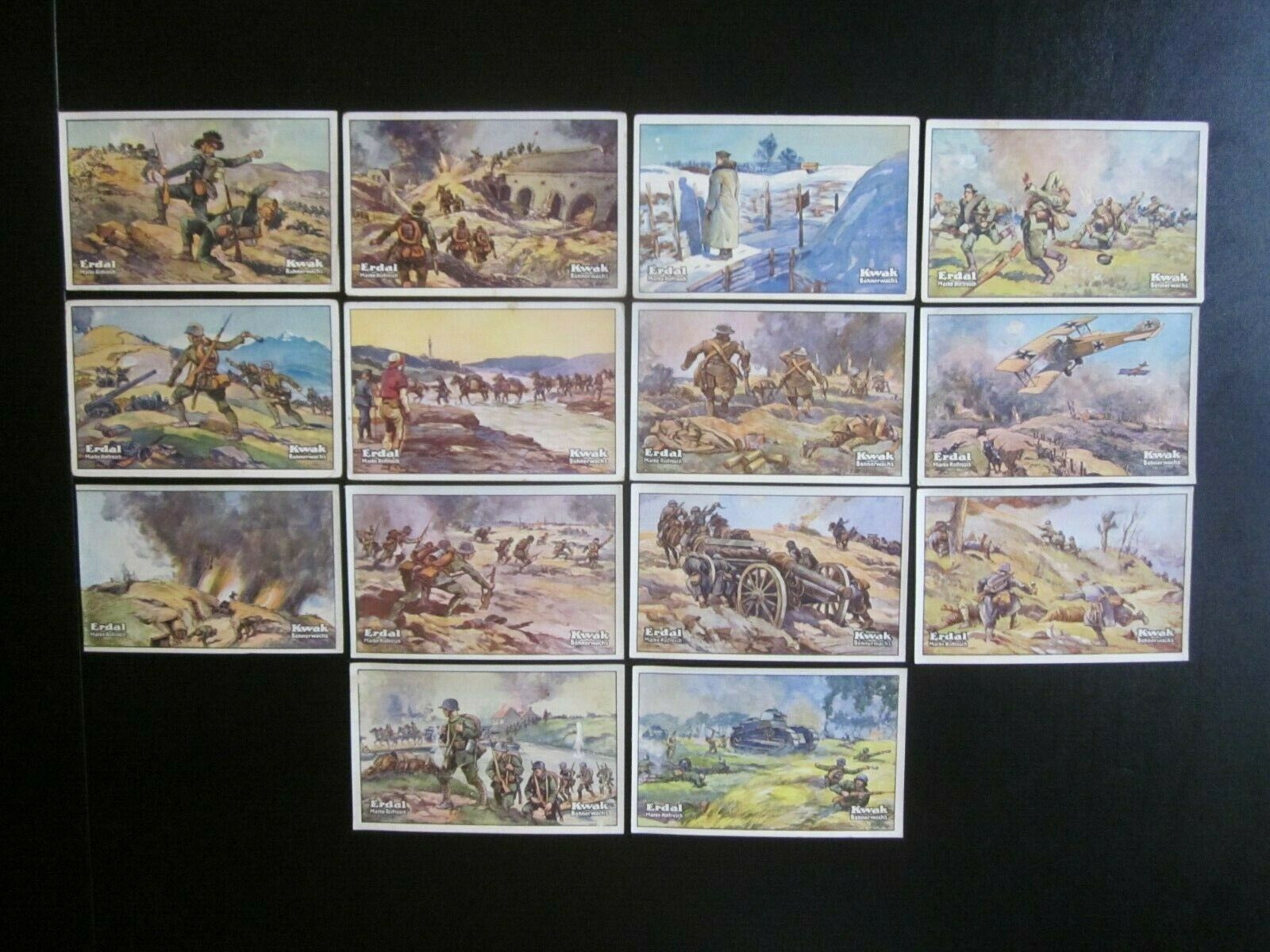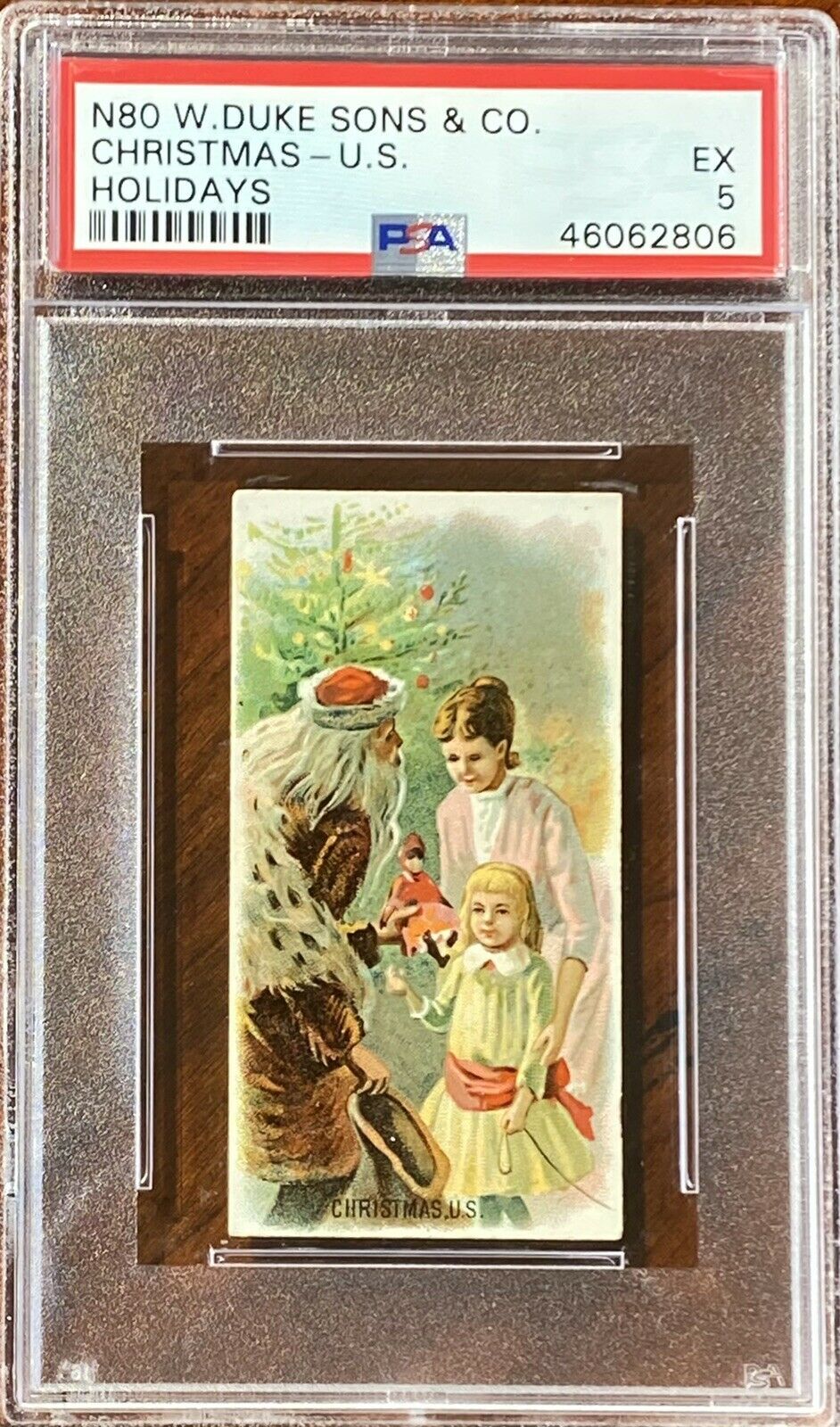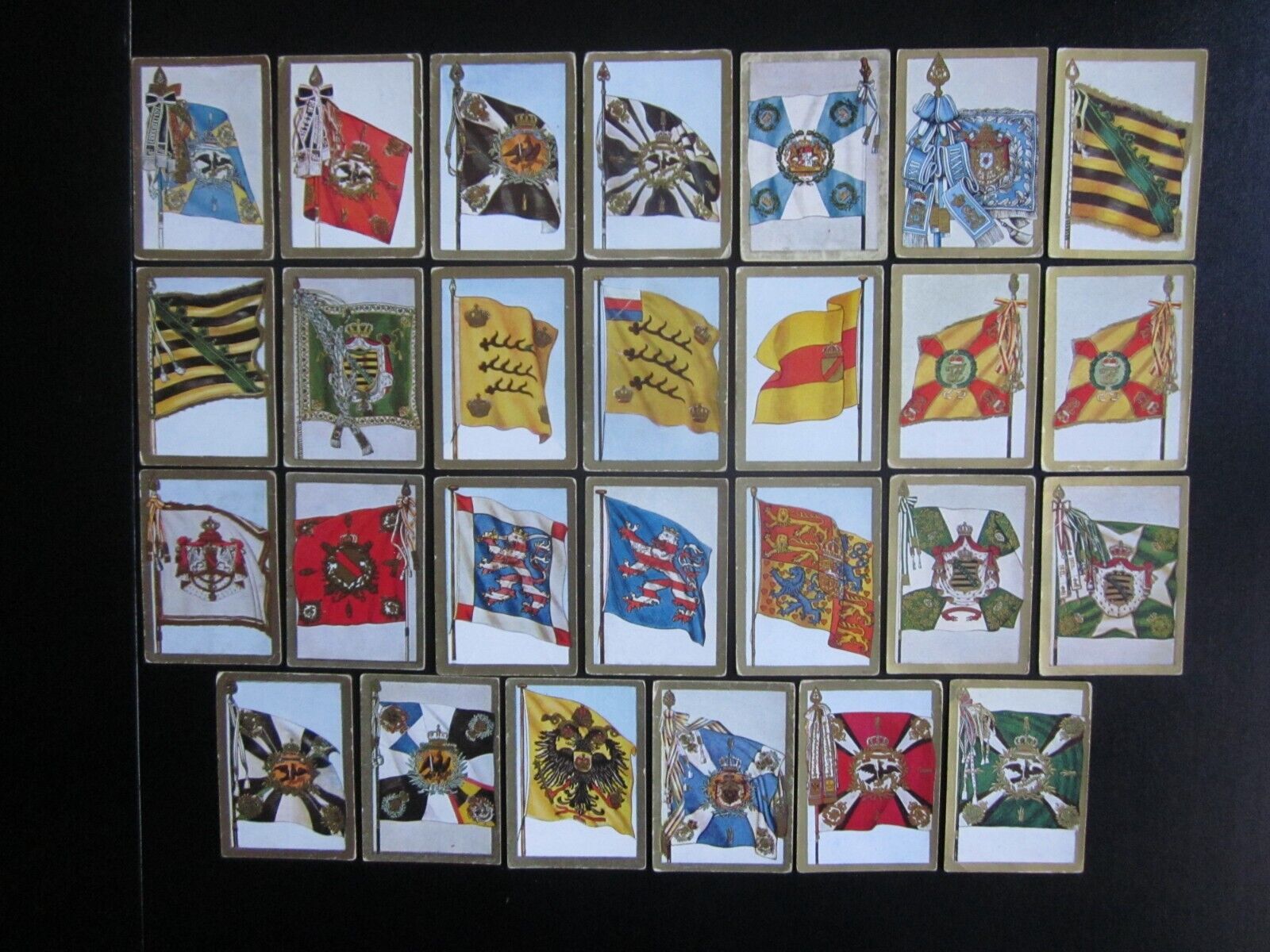-40%
14 large color German trade cards of WW1 action, issued 1934
$ 3.16
- Description
- Size Guide
Description
Offered here are 14 original German color trade cards of World War I action, issued in 1934 by the Erdal Shoe Polish Co. of Mainz, Germany for the albumDer Weltkrieg
(The World War). Pictured here are:
Series 9, Picture 3:
The Italians at Goerz. The fighting on the Isonzo Front in the mountains during the summer of 1915 concentrated around the city of Goerz. Trenches were dug in that area that changed hands repeatedly. In June and July 1915 the first three great battles of the Isonzo Front took place here. Our picture shows a scene from the third battle, in particular the attack by the elite Italian Bersaglieri troops on July 18
th
. Despite committing many men and much material to the attack, the Italians achieved no notable gains and had to give up all the positions that they first took.
Series 11, Picture 1:
The Western Front at Verdun (February 1916). Verdun...a sad monument to death, indeed the most powerful one of the entire war. No battle was bloodier. Our picture shows the beginning of the battle on February 21, 1916 when German troops achieved great success. On February 25
th
the French fortress Donaumont fell to the Germans in addition to much territory around it. The fighting continued until well into September at which point things settled down somewhat into a standoff of trench warfare.
Series 12, Picture 2:
At Prypet. Our picture shows the easternmost point reached by German troops in the war, at the massive marshlands of Kokitno through which German troops had to advance under terrible conditions in the winter of 1915-16. The main problem there was that the soft ground prevented the transport of artillery and vehicles of all sorts, while the enemy was safely behind well- fortified positions and could rain artillery shells on the advancing German troops.
Series 12, Picture 4:
Mass Attack by the Russians (Fall 1915). In the fall of 1915 German advances in the East reached their highpoint. The salient that had reached the German border was now made straight and the front was effectively a straight line from Riga to Czernowitz. There was little fighting during the winter, with both sides in fortified trenches. The spring and summer of 1916 once again saw considerable fighting and all along the front Russian troops try to storm the German trenches to make up for the defeats in the previous fall. Our picture shows one particular focal point of these mass attacks along the 350 kilometer front.
Series 12, Picture 5:
The collapse of the Italian Front at Isonzo. The largest battle on the Italian Front was the fighting at Tolmein and Flitsch on October 24, 1917. The goal of the German offensive was the capture of Karfreit, which is shown in our picture. The picture shows the Isonzo Valley and the attack of the Fourth Upper Silesian Infantry Regiment No. 63 and the Second Upper Silesian Infantry Regiment No. 23 (under von Winterfeldt), both of which led the attack. Two thousand Italians were captured when Karfreit was taken by the Germans.
Series 12, Picture 6:
In Albania before Durazzo. On June 24, 1916 German troops were able to capture the capital of Albania, the city of Durazzo, from the Italians. Once this happened, the Italians surrendered all of Albania. From the Adriatic Sea Italian warships shelled the Albanian coast. Our picture shows Albanian men, Bosnians, crossing a small river. The mosque in the background reminds us that we are in an Islamic land, in the northernmost part of its territory.
Series 13, Picture 2:
The Eastertide Battle at Arras. During the fighting around Arras and while a battle was also raging in the Champagne region, the English launched an attack on Easter Monday (April 9
th
) that is portrayed in our picture. Here we see Scottish troops attacking through the mud of a field pock-marked with the holes created by artillery fire. On the left is a burning tank. The English had a 3 to 1 advantage in manpower in this fighting, but the Germans did not give way and the British attack failed.
Series 13, Picture 4:
A Warplane Strafes a Trench. The German Luftwaffe (air force) changed its tactics over the course of the war, becoming more specialized. The planes that dropped bombs and engaged in dogfights now became solely heavy bombers, separate from the fighter planes that engaged other fighters. Lastly, observation planes helped the artillery with targeting. One other group was the so-called “Infantry Planes”, one of which is pictured here, that targeted troops in the trenches while the artillery laid down cover fire, as can be seen in the background.
Series 13, Picture 6:
An Exploding Mine Tunnel Under the Trenches. The fighting in the war occurred not only on the ground and in the air, but also under the ground. All along the Western front mines were dug by both sides toward and under enemy positions. Whoever was done first tunneling under the enemy could set off explosives first, destroying many of the enemy trenches and facilities. Our picture shows a mine being blown up.
Series 15, Picture 1:
The Great March Offensive of 1918. A great artillery barrage opened the offensive on March 21, 1918. History books would later call it "The Great Battle in France". Around 8 am the infantry began the attack. Our picture shows a scene from this attack which was directed against English and French positions in Arras, Cambrai and St. Quentin. This first part of the attack captured some 90,000 prisoners, 1,200 cannons and much more in supplies and ammunition. The goal of straightening the front at Chauny was thus achieved.
Series 15, Picture 2:
Artillery is Pulled Through the Destroyed Landscape. During the Great Offensive of March 1918 the German artillery achieved great precision in its targeting. The salvos were planned in advance in great detail, each shot down to the exact second. Without any preliminary fire the main barrage began right away. Coordinated with the movement of infantry, the artillery farthest to the rear began fire first in the morning hours. Then, as artillery farther toward the front opened fire, the guns to the rear moved forward ahead of the firing cannons. This picture shows artillery units moving into areas recently abandoned by the enemy.
Series 15, Picture 3:
Storming Mount Kemmel. On April 25, 1918 at 6:45 in the morning German infantry began the storming of Mount Kemmel. Halfway up the mountain there was heavy fighting in and around the houses there. Nevertheless, mountain troops and Bavarian units soon overran the summit. Machine-gun nest were taken in hand-to-hand fighting and soon also the village of Kemmel. Our picture shows a scene from this fighting. In the days that followed the English and French made counterattacks that lasted until May 20
th
but these attacks were unsuccessful.
Series 15, Picture 4:
Crossing the Marne. On the 27
th
of May 1918 between Soissons and Reims German troops launched a surprise attack in the early morning hours after a few hours of artillery fire. The German troops were able to advance quickly all the way to Chateau-Thierry near the Marne River. A 20-kilometer stretch from here to Verneuil fell into German hands. Only then could the surprised enemy begin to offer resistance. Our picture shows advanced German troops crossing the Marne on the 4
th
day of fighting.
Series 15, Picture 5:
Surprise Attack by French Tanks. The tank was a creation of World War 1. The English were the first to use tanks in battle and soon all the nations involved in the war followed their example. In this early phase both sides tried to build the tanks as large as possible and outfit them with as many cannons and machine guns as they could. The French then used a different system and built smaller tanks with just one cannon that could move quickly. Our picture shows a surprise attack by French tanks during the fighting around Aisne on the Marne River in July of 1918.
Each card measures 4 and 1/4 inches by 2 and 3/4 inches.
With multiple purchases, please wait for the invoice for reduced shipping.










